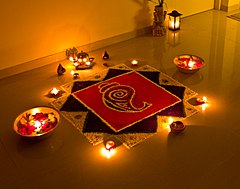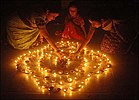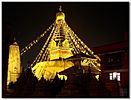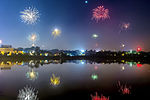Divali
| Diwali / Deepavali | |
|---|---|

Rangoli decorations, made using coloured powder or sand, are popular during Diwali
|
|
| Also called | Deepavali |
| Observed by | Hindus, Sikhs, Jains and Newar Buddhists |
| Type | Cultural, Seasonal, Religious |
| Celebrations | Diya and lighting, home decoration, shopping, fireworks, puja (prayers), gifts, performing religious rituals, feast and sweets |
| Begins | Dhanteras, 2 days before Diwali |
| Ends | Bhai Dooj, 2 days after Diwali |
| Date | Varies per Hindu Lunisolar calendar |
| 2017 date | 19 October (Thursday) in North India 18 October (Wednesday) in South India and SE Asia |
| 2018 date | 7 November (Wednesday) in North india,Andhra Pradesh,telangana and western india6 November(Tuesday) in south india |
| 2019 date | 27 October (Sunday) Throughout India |
| Related to | Kali Puja, Galungan, Diwali (Jainism), Bandi Chhor Divas, Tihar, Swanti |
Diwali festivities include a celebration of sights, sounds, arts and flavors. The festivities vary between different regions.
|
|||||||||
Diwali or Deepavali is the Hindu festival of lights celebrated every year in autumn in the northern hemisphere (spring in southern hemisphere). It is an official holiday in Fiji, Guyana, India,Malaysia, Mauritius, Myanmar, Nepal, Singapore, Sri Lanka, Suriname, Trinidad and Tobago and recently Sindh Province in Pakistan. One of the major festivals of Hinduism, it spiritually signifies the victory of light over darkness, good over evil, knowledge over ignorance, and hope over despair. Its celebration includes millions of lights shining on housetops, outside doors and windows, around temples and other buildings in the communities and countries where it is observed. The festival preparations and rituals typically extend over a five-day period, but the main festival night of Diwali coincides with the darkest, new moon night of the Hindu Lunisolar month Kartika in Bikram Sambat calendar. In the Gregorian calendar, Diwali night falls between mid-October and mid-November.
Before Diwali night, people clean, renovate, and decorate their homes and offices. On Diwali night, people dress up in new clothes or their best outfit, light up diyas (lamps and candles) inside and outside their home, participate in family puja (prayers) typically to Lakshmi – the goddess of fertility and prosperity. After puja, fireworks follow, then a family feast including mithai (sweets), and an exchange of gifts between family members and close friends. Deepavali also marks a major shopping period in nations where it is celebrated.
The name of festive days as well as the rituals of Diwali vary significantly among Hindus, based on the region of India. In many parts of India, the festivities start with Dhanteras (in Northern and Western part of India), followed by Naraka Chaturdasi on second day, Deepavali on the third day, Diwali Padva dedicated to wife–husband relationship on the fourth day, and festivities end with Bhai Dooj dedicated to sister–brother bond on the fifth day. Dhanteras usually falls eighteen days after Dussehra.
...
Wikipedia








